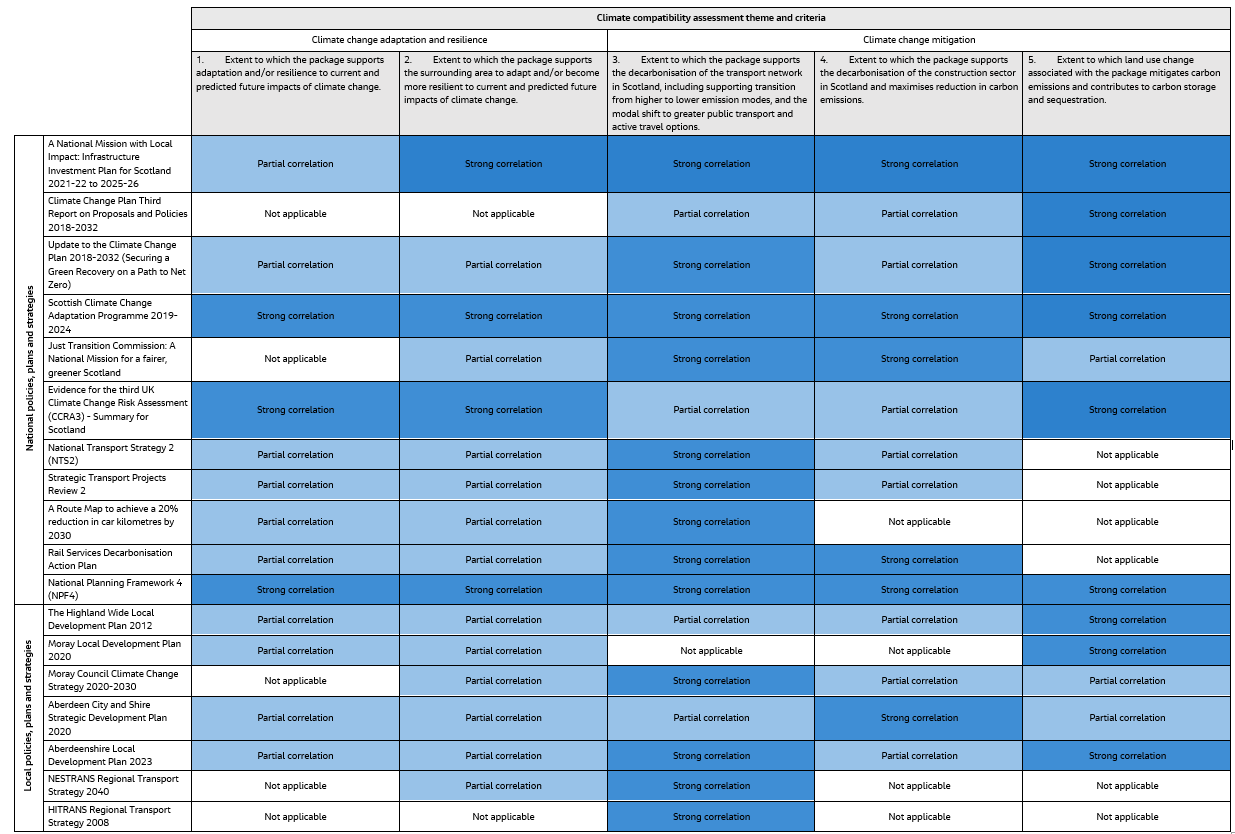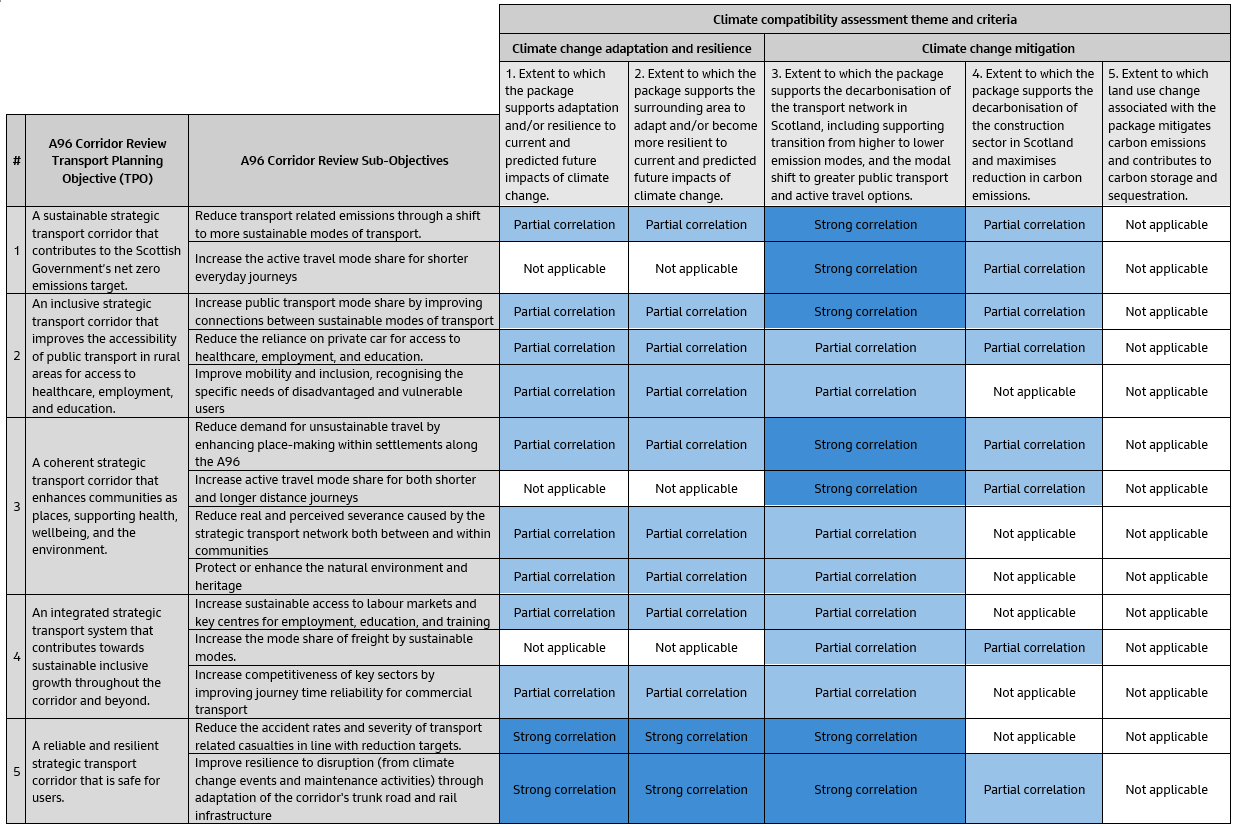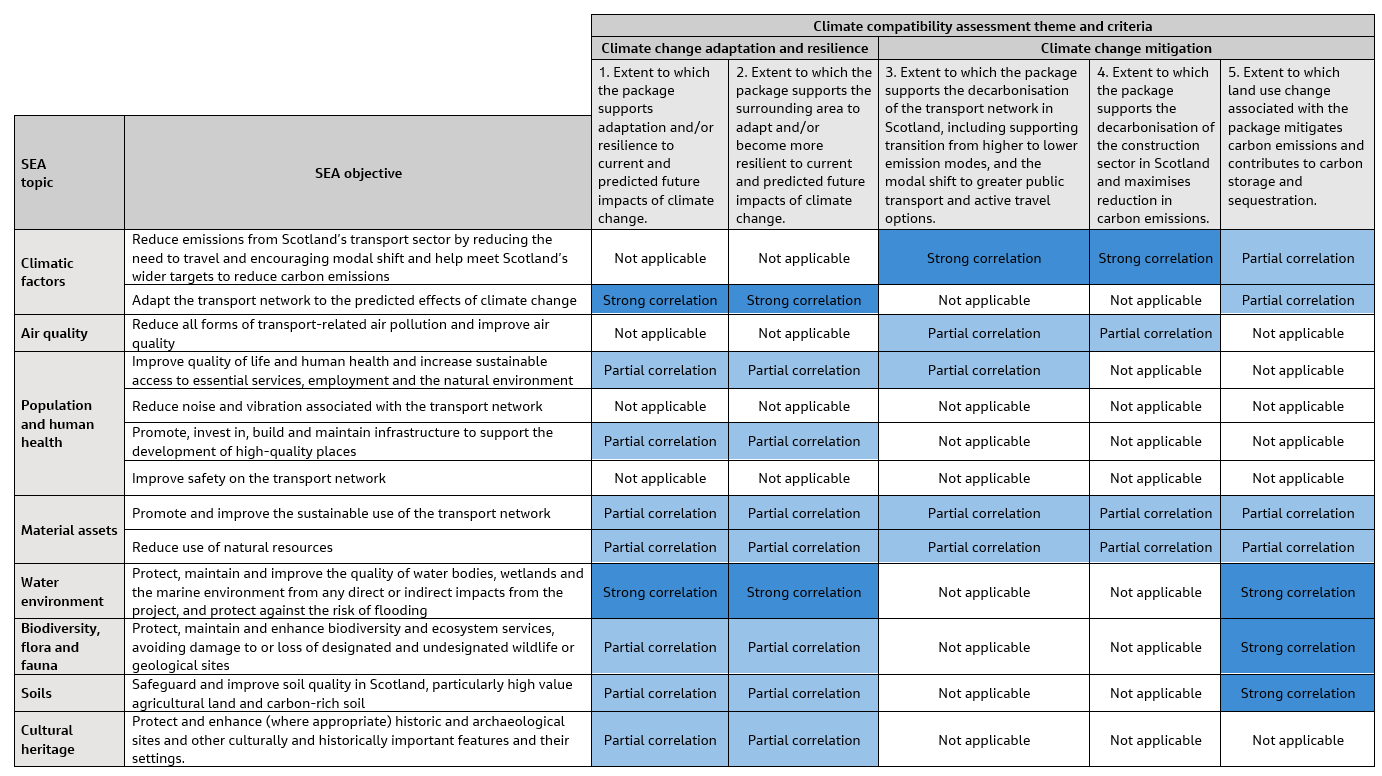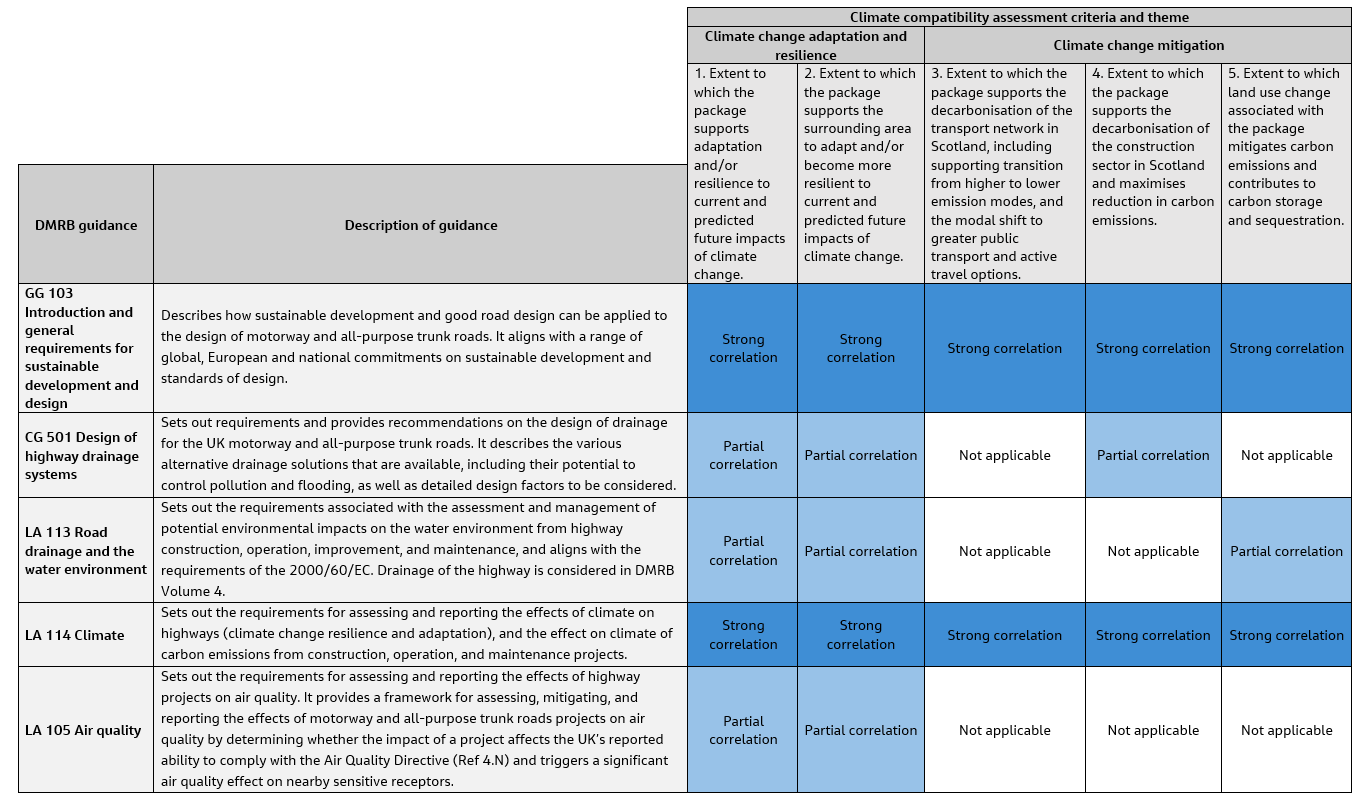Methodology to develop a climate compatibility assessment
Overview
The following methodology was used to develop the climate compatibility assessment:
- literature and best practice review;
- policy context and alignment;
- transport guidance, processes and assessments gap analysis; and
- criteria development, testing and refinement.
Literature and best practice review
A review of public sector and academic literature was undertaken to provide insights into previous attempts to measure the climate change compatibility of projects, schemes and whole industries.
The literature and best practice review was used to:
- gain an understanding of the maturity of research into climate change compatibility or alignment; and
- create a theoretical framework of criteria to assess climate change compatibility.
Professional knowledge and experience were supplemented with online search engines to identify suitable literature for review, searching for relatable content with reference to various themes, including alignment with the Paris Agreement, the Glasgow Climate Pact, decarbonisation, climate change risk assessments, and measuring against the United Nations Sustainable Development Goals (UN SDGs).
Each piece of literature was reviewed to identify:
- key themes – how the assessment related to the topic of climate change compatibility;
- methodology – what approach was used to test the compatibility of the focus project/sector to a particular key theme; and
- strengths and limitations associated with each assessment.
The literature review highlighted the lack of similar assessments that exist to date. The results from the review, however, did identify key themes that informed the development of the climate compatibility assessment:
- The acknowledgement that both climate change adaptation and resilience, and climate change mitigation, are key climate outcomes.
- The use of qualitative (positive/negative lists) and quantitative (e.g. carbon emissions) metrics to provide data for assessments.
- The consideration of ‘Paris-Aligned’, ‘Misaligned’ and ‘Conditionally Aligned’ to assess the alignment of transport infrastructure investments.
- The acknowledgement that additional environmental outcomes, including water quality, air quality, waste and circular economy, nature and biodiversity, and a just transition may be indirectly impacted by climate change.
Policy context and alignment
The climate compatibility assessment was developed in the context of relevant Scottish national, regional and local policies, plans and strategies relating to climate change (0 and 0). Most of Scotland’s national policies and strategies are published within the context of the statutory requirements of the Climate Change (Scotland) Act 2009 , and the Climate Change (Emissions Reduction Targets) Act 2019 .
The National Transport Strategy 2 (NTS2) and the National Planning Framework (NPF4) have been prepared following the introduction of legislation which requires both plans to be prepared with consideration of how they will contribute to the achievement of statutory outcomes. Those outcomes include how the strategy and framework contribute to the national emission reduction targets as per the Climate Change Acts.
All the climate compatibility assessment criteria are fully supported by at least one national policy/plan/strategy (see Figure 2.3.1 ). This shows that the criteria are representative of the relevant policies, plans and strategies. The table uses ‘Not applicable’ for when a national policy/plan/strategy is not relevant to a specific a specific climate change criterion by virtue of the scope of the policy/plan/strategy.
See 0 for the justification of the alignment between the relevant national policies, plans and strategies relating to the climate compatibility assessment criteria.

Climate change considerations in transport guidance, processes and assessments
- STAG criteria for Environment and Climate Change ( Figure 2.5.1 );
- Draft STAG Transport Planning Objectives (TPOs) ( Figure 2.5.2 );
- SEA objectives ( Figure 2.6.1 ); and
- Relevant parts of the Design Manual for Roads and Bridges (DMRB) ( Figure 2.7.1 ).
The existing transport guidance, processes and assessments do not require a specific climate compatibility assessment as described in this report. However, in combination, the processes reviewed provide good coverage of the climate compatibility assessment criteria, with no significant gaps.
The existing transport guidance, processes and assessments reviewed provide a balanced assessment or appraisal covering wider environmental, social and economic aspects, including climate change aspects. This balanced approach is something that a stand-alone climate compatibility assessment does not provide. The following sub-sections provide additional context and information on the processes reviewed.
Scottish Transport Appraisal Guidance (STAG)
The transport appraisal for the A96 Corridor Review is being carried out in accordance with STAG, which is an objective-led, evidence-based, transport appraisal process.
The A96 Corridor Review Case for Change was the first stage of the STAG process, setting out the justification for taking the study forward. For the A96 Corridor Review, this included:
- a review of current national, regional and local strategy and policy documents used to provide the policy context for the review
- determination of the geographic, socio-economic, environmental and transport context for the transport appraisal study area
- the identification and definition of the key problems and opportunities for the transport corridor, developed from the evidence base that included analyses of a wide range of datasets, and supported by information obtained from the engagement activities that were undertaken and in particular through stakeholder engagement workshops and an online public consultation survey
- the development of overarching Transport Planning Objectives (TPOs), each with a set of corridor-specific sub-objectives, based on the identified problems and opportunities
- the generation and sifting of option suggestions applicable and relevant to the transport corridor.
As the STAG process progressed into the preliminary and detailed appraisal stages, the A96 Full Dualling and all six packages were appraised against the project specific TPOs, STAG criteria, established policy objectives and deliverability.
As per the updated STAG criteria on Climate Change, the quantification and monetisation of carbon emission impacts as a result of transport user emissions has been determined for the A96 Full Dualling and all six packages at the detailed appraisal stage.
Figure 2.5.1 and Figure 2.5.2 show that the STAG criteria for Environment and Climate Change and the STAG TPOs are well correlated with the climate compatibility assessment criteria. The tables use ‘Not applicable’ for when a STAG Criteria for Environment and Climate Change or STAG TPO is not relevant to a specific climate change criterion by virtue of the scope of the STAG Criteria for Environment and Climate Change or STAG TPO.
Figure 2.5.1: Correlation of the STAG environment and climate change sub-criteria with the climate compatibility assessment criteria

Strategic Environmental Assessment (SEA)
SEA aims to offer greater protection to the environment by ensuring public bodies (in this case, Transport Scotland) and those organisations preparing plans of a ‘public character’ consider and address the likely significant environmental effects.
The SEA process began with the screening stage which determined that an SEA was required. This conclusion was confirmed by the SEA Consultation Authorities: NatureScot, SEPA and Historic Environment Scotland.
The SEA topics, to be considered at all SEA stages, are:
- biodiversity, fauna and flora;
- population and human health;
- water and soil;
- air;
- climatic factors;
- material assets;
- cultural heritage; and
- landscape.
The SEA utilises a set of objectives that cover each of the environmental topics scoped into the assessment. The SEA objectives have been developed for the STPR2 SEA and further developed for the A96 Corridor Review. Objectives for the climatic factors topic include:
- Reduce emissions from Scotland’s transport sector by reducing the need to travel and encouraging modal shift to help meet Scotland’s wider targets to reduce greenhouse gas emissions.
- Adapt the transport network to the predicted effects of climate change.
Figure 2.6.1 demonstrates that the SEA Objectives correlate with the climate change compatibility criteria. The table uses ‘Not applicable’ for when the SEA Objective is not relevant to a specific climate change criterion by virtue of the scope of the SEA Objective.

Design Manual for Roads and Bridges (DMRB)
The level of detail increases throughout the DMRB stages:
- Stage 1: Preliminary Assessment
- Stage 2: Route Option Assessment
- Stage 3: Scheme Assessment
-
- Many DMRB documents have direct and indirect relationships to climate change impacts. To focus the review of DMRB in relation to the climate compatibility criteria, the following DMRB documents were identified as of greatest relevance:
-
- GG 103: Introduction and general requirements for sustainable development and design . This document introduces the general requirements for sustainable development and design.
- CG 501: Design of highway drainage systems . This document contains the over-arching requirements for drainage design of highways.
- LA 113: Road drainage and the water environment . This document describes the requirements for assessment and management of the impacts that road projects can have on the water environment.
- LA 114: Climate . This document sets out the requirements for assessing and reporting the effects of climate on highways (climate change resilience and adaptation), and the effect on climate of carbon emissions from construction, operation and maintenance projects.
- LA 105: Air Quality . This document sets out the requirements for assessing and reporting the effects of highway projects on air quality.
Figure 2.7.1 shows that the above DMRB guidance correlates with the climate compatibility criteria. The table uses ‘Not applicable’ for when the DMRB guidance is not relevant to a specific climate change criterion by virtue of the scope of the DMRB guidance.
